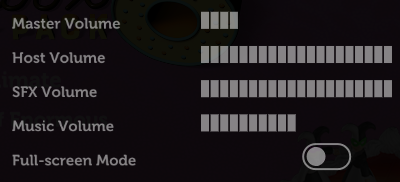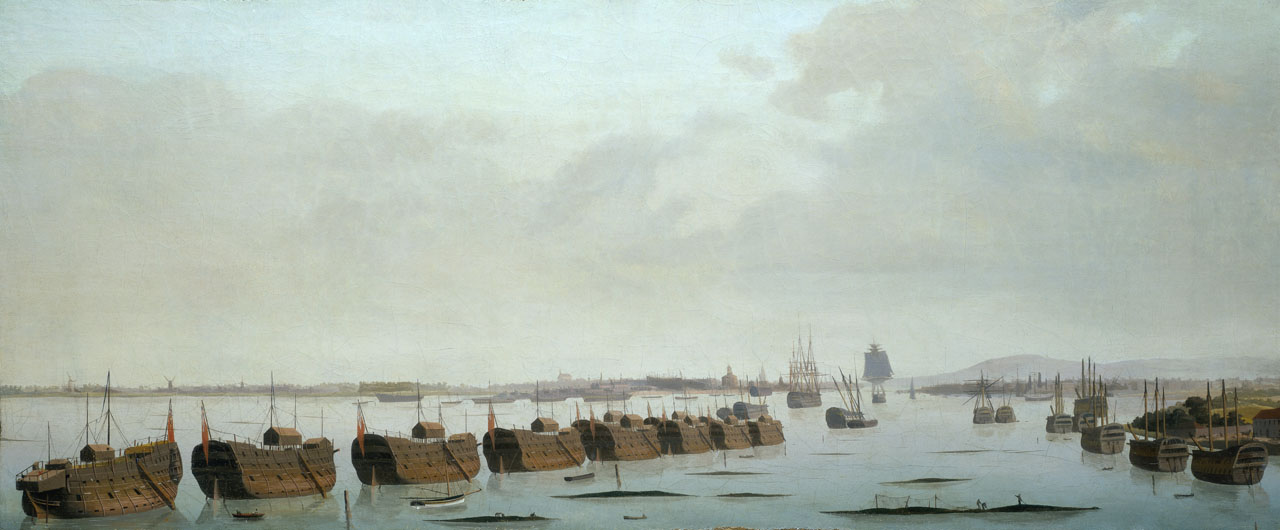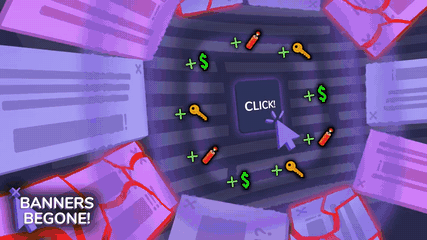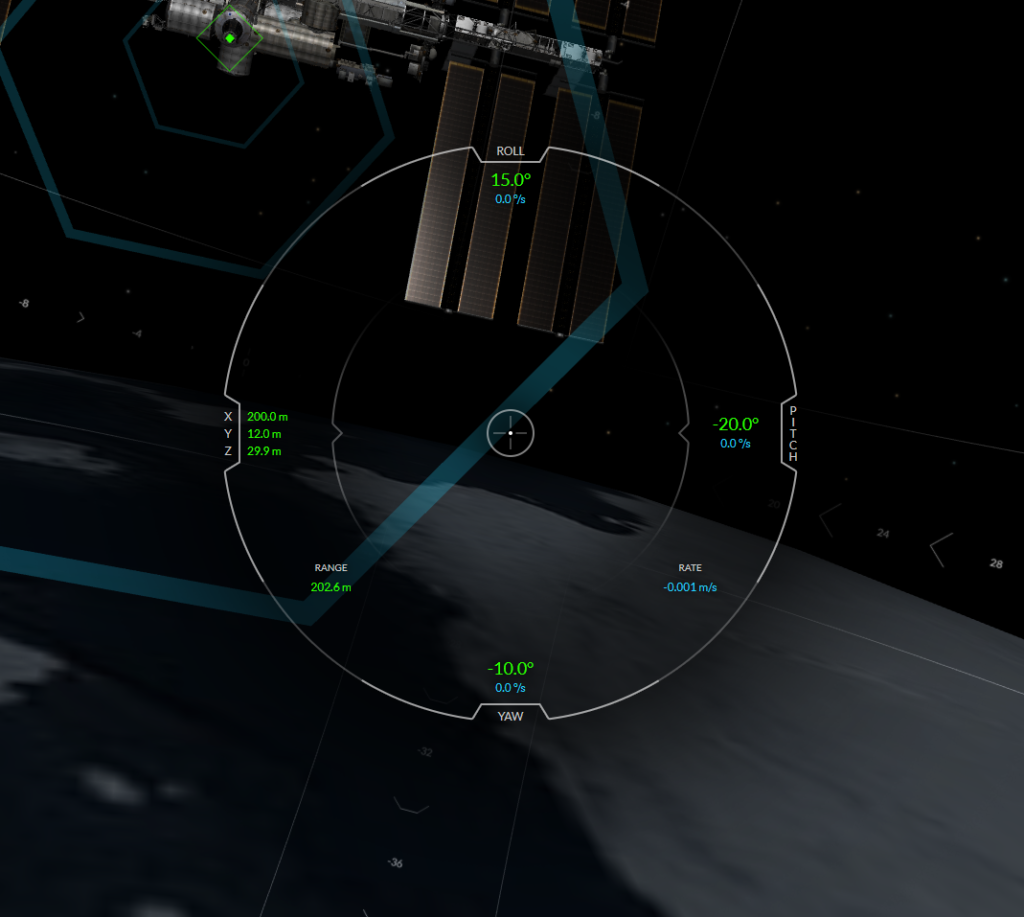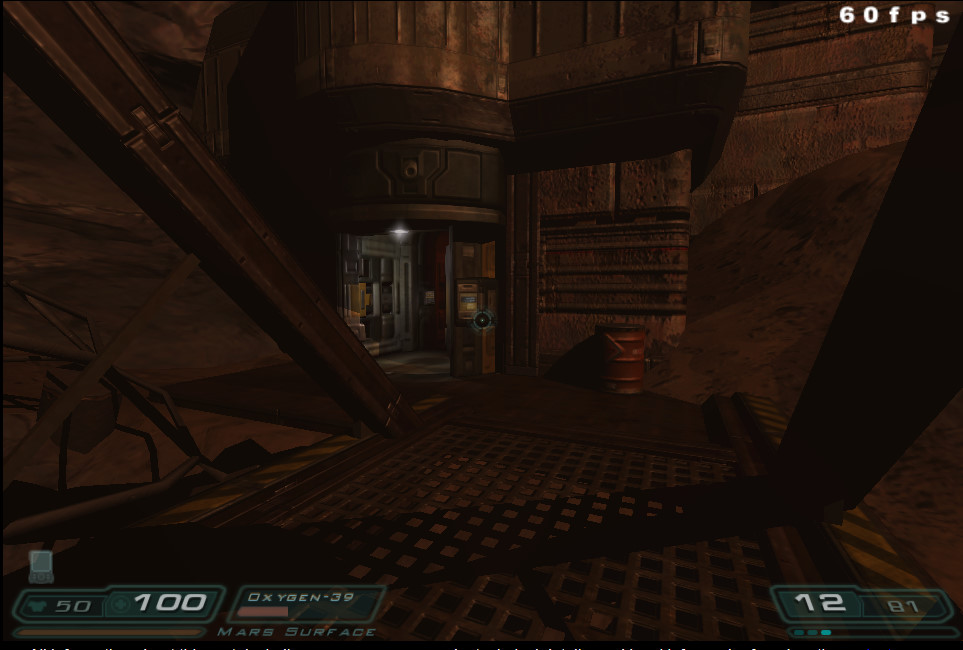This video accompanies a blog post of the same title. The content is basically the same – if you prefer videos, watch this video. If you prefer blog posts, go read the blog post. You might also like to play with my Mastermind solver or view the source code.
Tag: games
Beating Children at Mastermind
This blog post is also available as a video. Would you prefer to watch/listen to me tell you about how I’ve implemented a tool to help me beat the kids when we play Mastermind?
I swear that I used to be good at Mastermind when I was a kid. But now, when it’s my turn to break the code that one of our kids has chosen, I fail more often than I succeed. That’s no good!

Mastermind and me
Maybe it’s because I’m distracted; multitasking doesn’t help problem-solving. Or it’s because we’re “Super” Mastermind, which differs from the one I had as a child in that eight (not six) peg colours are available and secret codes are permitted to have duplicate peg colours. These changes increase the possible permutations from 360 to 4,096, but the number of guesses allowed only goes up from 8 to 10. That’s hard.
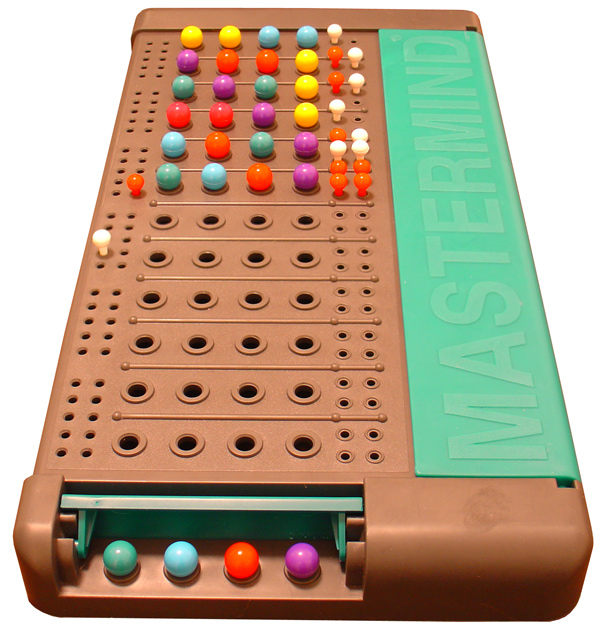
Or maybe it’s just that I’ve gotten lazy and I’m now more-likely to try to “solve” a puzzle using a computer to try to crack a code using my brain alone. See for example my efforts to determine the hardest hangman words and make an adverserial hangman game, to generate solvable puzzles for my lock puzzle game, to cheat at online jigsaws, or to balance my D&D-themed Wordle clone.
Hey, that’s an idea. Let’s crack the code… by writing some code!
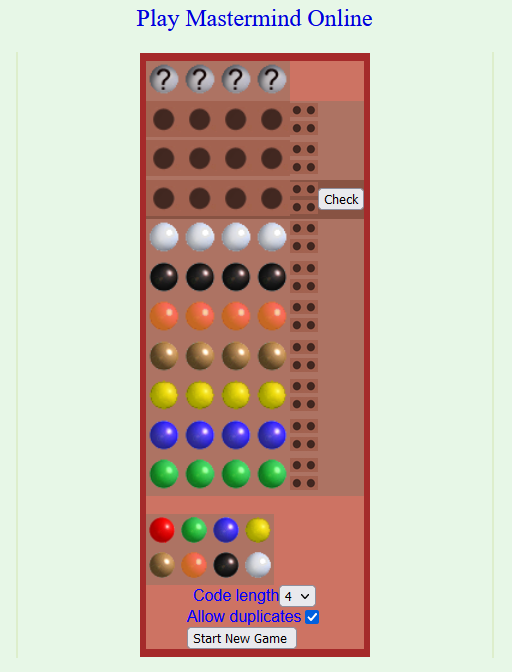
Representing a search space
The search space for Super Mastermind isn’t enormous, and it lends itself to some highly-efficient computerised storage.
There are 8 different colours of peg. We can express these colours as a number between 0 and 7, in three bits of binary, like this:
| Decimal | Binary | Colour |
|---|---|---|
0
|
000
|
Red |
1
|
001
|
Orange |
2
|
010
|
Yellow |
3
|
011
|
Green |
4
|
100
|
Blue |
5
|
101
|
Pink |
6
|
110
|
Purple |
7
|
111
|
White |
There are four pegs in a row, so we can express any given combination of coloured pegs as a 12-bit binary number. E.g. 100 110 111 010 would represent the
permutation blue (100), purple (110), white (111), yellow (010). The total search space, therefore, is the range of numbers from
000000000000 through 111111111111… that is: decimal 0 through 4,095:
| Decimal | Binary | Colours |
|---|---|---|
0
|
000000000000
|
Red, red, red, red |
1
|
000000000001
|
Red, red, red, orange |
2
|
000000000010
|
Red, red, red, yellow |
| ………… | ||
4092
|
|
White, white, white, blue |
4093
|
|
White, white, white, pink |
4094
|
|
White, white, white, purple |
4095
|
|
White, white, white, white |
Whenever we make a guess, we get feedback in the form of two variables: each peg that is in the right place is a bull; each that represents a peg in the secret code but isn’t in the right place is a cow (the names come from Mastermind’s precursor, Bulls & Cows). Four bulls would be an immediate win (lucky!), any other combination of bulls and cows is still valuable information. Even a zero-score guess is valuable- potentially very valuable! – because it tells the player that none of the pegs they’ve guessed appear in the secret code.
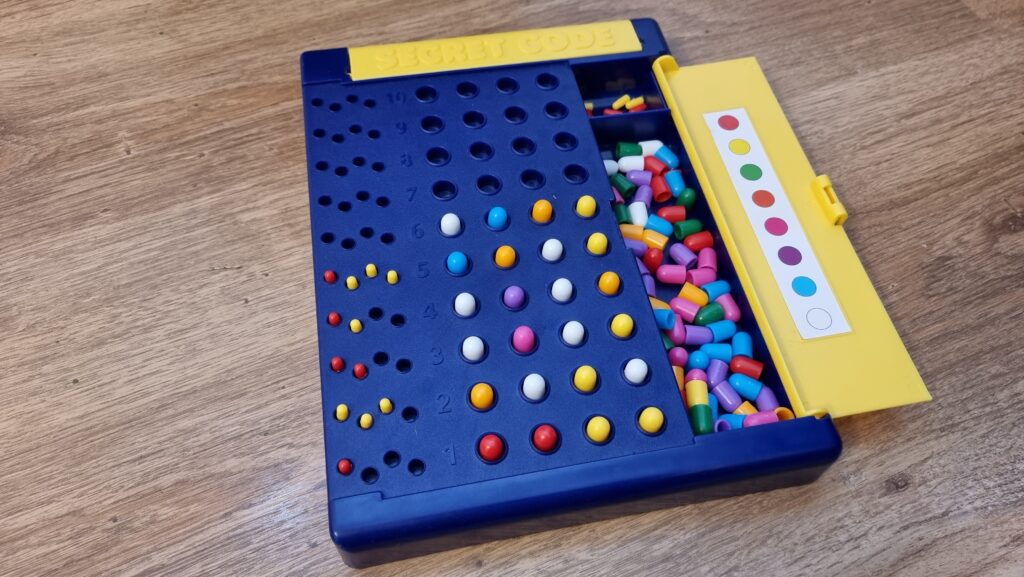
Solving with Javascript
The latest versions of Javascript support binary literals and bitwise operations, so we can encode and decode between arrays of four coloured pegs (numbers 0-7) and the number 0-4,095
representing the guess as shown below. Decoding uses an AND bitmask to filter to the requisite digits then divides by the order of magnitude. Encoding is just a reduce
function that bitshift-concatenates the numbers together.
116 117 118 119 120 121 122 123 124 125 126 127 128 129 130 131 132 133 134 |
/** * Decode a candidate into four peg values by using binary bitwise operations. */ function decodeCandidate(candidate){ return [ (candidate & 0b111000000000) / 0b001000000000, (candidate & 0b000111000000) / 0b000001000000, (candidate & 0b000000111000) / 0b000000001000, (candidate & 0b000000000111) / 0b000000000001 ]; } /** * Given an array of four integers (0-7) to represent the pegs, in order, returns a single-number * candidate representation. */ function encodeCandidate(pegs) { return pegs.reduce((a, b)=>(a << 3) + b); } |
With this, we can simply:
- Produce a list of candidate solutions (an array containing numbers 0 through 4,095).
- Choose one candidate, use it as a guess, and ask the code-maker how it scores.
- Eliminate from the candidate solutions list all solutions that would not score the same number of bulls and cows for the guess that was made.
- Repeat from step #2 until you win.
Step 3’s the most important one there. Given a function getScore( solution, guess ) which returns an array of [ bulls, cows ] a given guess would
score if faced with a specific solution, that code would look like this (I’m convined there must be a more-performant way to eliminate candidates from the list with XOR
bitmasks, but I haven’t worked out what it is yet):
164 165 166 167 168 169 170 171 172 173 174 175 176 177 178 179 180 181 182 |
/** * Given a guess (array of four integers from 0-7 to represent the pegs, in order) and the number * of bulls (number of pegs in the guess that are in the right place) and cows (number of pegs in the * guess that are correct but in the wrong place), eliminates from the candidates array all guesses * invalidated by this result. Return true if successful, false otherwise. */ function eliminateCandidates(guess, bulls, cows){ const newCandidatesList = data.candidates.filter(candidate=>{ const score = getScore(candidate, guess); return (score[0] == bulls) && (score[1] == cows); }); if(newCandidatesList.length == 0) { alert('That response would reduce the candidate list to zero.'); return false; } data.candidates = newCandidatesList; chooseNextGuess(); return true; } |
I continued in this fashion to write a full solution (source code). It uses ReefJS for component rendering and state management, and you can try it for yourself right in your web browser. If you play against the online version I mentioned you’ll need to transpose the colours in your head: the physical version I play with the kids has pink and purple pegs, but the online one replaces these with brown and black.
Testing the solution
Let’s try it out against the online version:
As expected, my code works well-enough to win the game every time I’ve tried, both against computerised and in-person opponents. So – unless you’ve been actively thinking about the specifics of the algorithm I’ve employed – it might surprise you to discover that… my solution is very-much a suboptimal one!
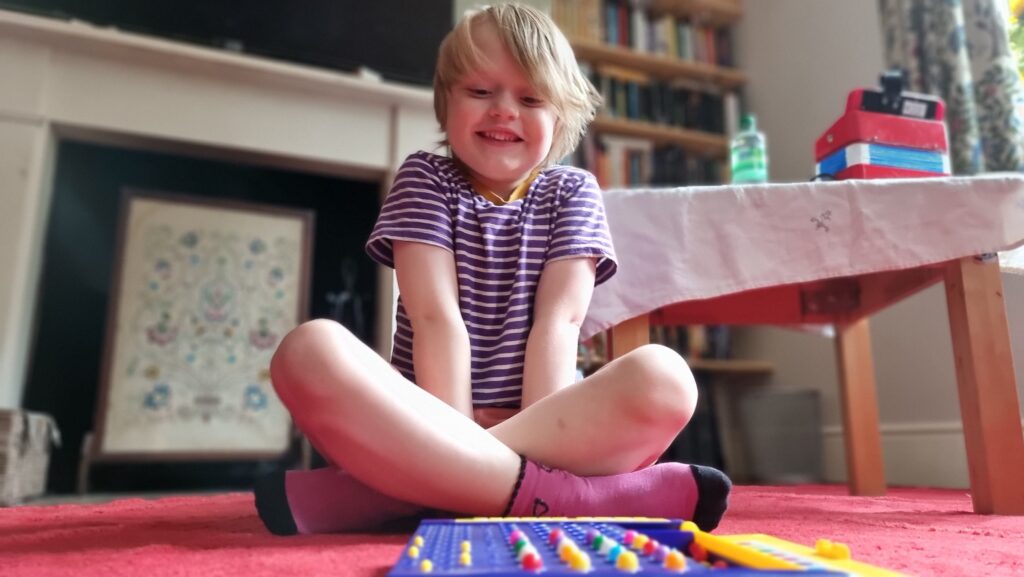
My solution is suboptimal
A couple of games in, the suboptimality of my solution became pretty visible. Sure, it still won every game, but it was a blunt instrument, and anybody who’s seriously thought about games like this can tell you why. You know how when you play e.g. Wordle (but not in “hard mode”) you sometimes want to type in a word that can’t possibly be the solution because it’s the best way to rule in (or out) certain key letters? This kind of strategic search space bisection reduces the mean number of guesses you need to solve the puzzle, and the same’s true in Mastermind. But because my solver will only propose guesses from the list of candidate solutions, it can’t make this kind of improvement.
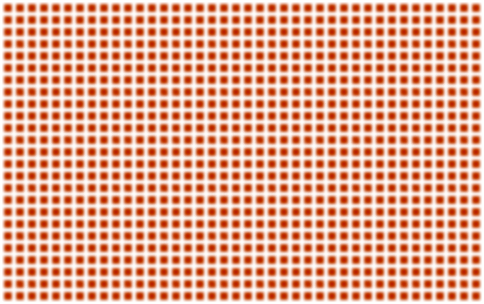
Search space bisection is also used in my adverserial hangman game, but in this case the aim is to split the search space in such a way that no matter what guess a player makes, they always find themselves in the larger remaining portion of the search space, to maximise the number of guesses they have to make. Y’know, because it’s evil.

There are mathematically-derived heuristics to optimise Mastermind strategy. The first of these came from none other than Donald Knuth (legend of computer science, mathematics, and pipe organs) back in 1977. His solution, published at probably the height of the game’s popularity in the amazingly-named Journal of Recreational Mathematics, guarantees a solution to the six-colour version of the game within five guesses. Ville [2013] solved an optimal solution for a seven-colour variant, but demonstrated how rapidly the tree of possible moves grows and the need for early pruning – even with powerful modern computers – to conserve memory. It’s a very enjoyable and readable paper.
But for my purposes, it’s unnecessary. My solver routinely wins within six, maybe seven guesses, and by nonchalantly glancing at my phone in-between my guesses I can now reliably guess our children’s codes quickly and easily. In the end, that’s what this was all about.
Printing Maps from Dungeondraft
I really love Dungeondraft, an RPG battle map generator. It’s got great compatibility with online platforms like Foundry VTT and Roll20, but if you’re looking to make maps for tabletop play, there’s a few tips I can share:
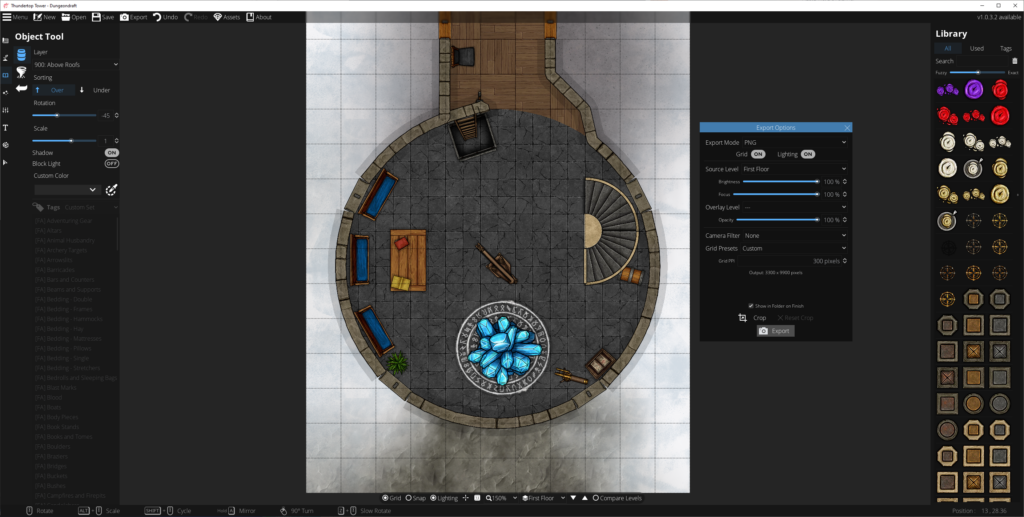
Planning and designing
Dungeondraft has (or can be extended with) features to support light levels and shadow-casting obstructions, openable doors and windows, line-of sight etc… great to have when you’re building for Internet-enabled tabletops, but pointless when you’re planning to print out your map! Instead:
- Think about scale: I’m printing to A4 sheets and using inch-size squares, so every 11 x 8 squares equates to one sheet of paper. Knowing this, I can multiply-up to a whole number of sheets of paper and this informs my decisions about how to best make use of the maps (and what will and won’t fit on my dining table!).
- Focus on legibility: Your printer probably won’t have the same kind of resolution as your screen, and your players can’t “zoom in” to get details. Play with the grid styles (under Map Settings) to find what works best for you, and try not to clash with your floor patterns. If you’re printing in monochrome, use the “Printer-Friendly” camera filter (also under Map Settings, or in the Export Options dialog) to convert to gorgeous line-art. Make sure critical elements have sufficient contrast that they’ll stand out when printed or your players might walk right over that chest, campfire, or bookshelf.
- Think about exposure: You don’t get digital “fog of war” on the tabletop! Think about how you’re going to reveal the map to your players: plan to print in multiple sections to put together, jigsaw style, or have card to “cover” bits of the map. Think about how the tool can help you here: e.g. if you’ve got multiple buildings the players can explore, use a higher “level” or roof layer to put roofs on your buildings, then print the relevant parts of that level separately: now you’ve got a thematic cover-up that you can remove to show the insides of the building. Go the other way around for secret doors: print the empty wall on your main map (so players can’t infer the location of the secret door by the inclusion of a cover-up) and the secret door/passage on the overlay, so you can stick it onto the map when they find it.
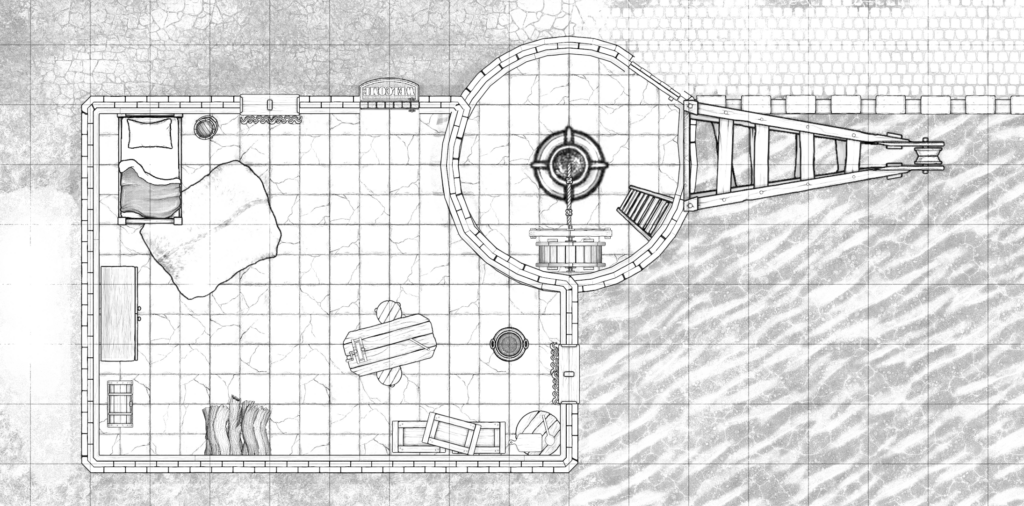
Printing it out
There’s no “print” option in Dungeondraft, so – especially if your map spans multiple “pages” – you’ll need a multi-step process to printing it out. With a little practice, it’s not too hard or time-consuming, though:
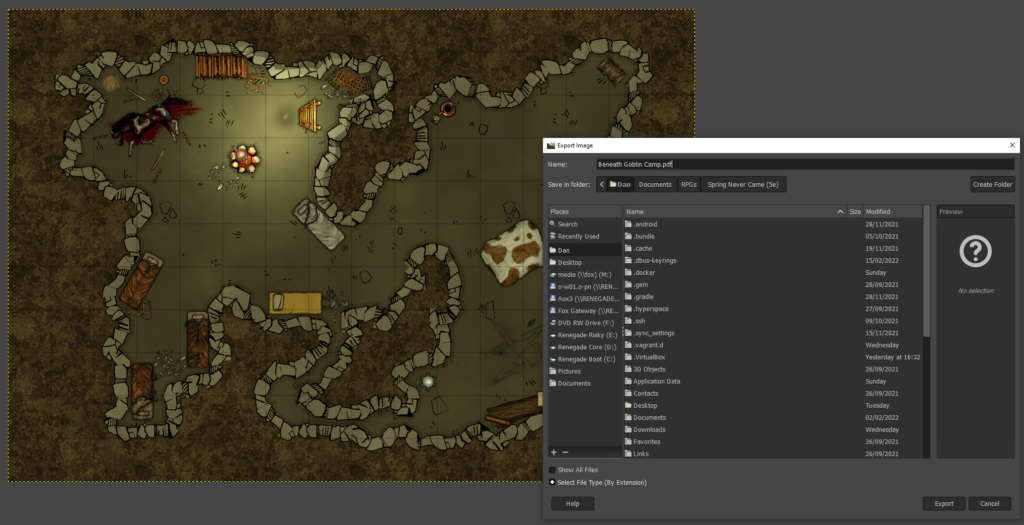
Export your map (level by level) from Dungeondraft as PNG files. The default settings are fine, but pay attention to the “Overlay level” setting if you’re using smart or complex cover-ups as described above.
To easily spread your map across multiple pages, you’ll need to convert it to a PDF. I’m using Gimp to do this. Simply open the PNG in Gimp, make any post-processing/last minute changes that you couldn’t manage in Dungeondraft, then click File >
Export As… and change the filename to have a .pdf extension. You could print directly from Gimp, but in my experience PDF reader software does a much better job at multi-page printing.
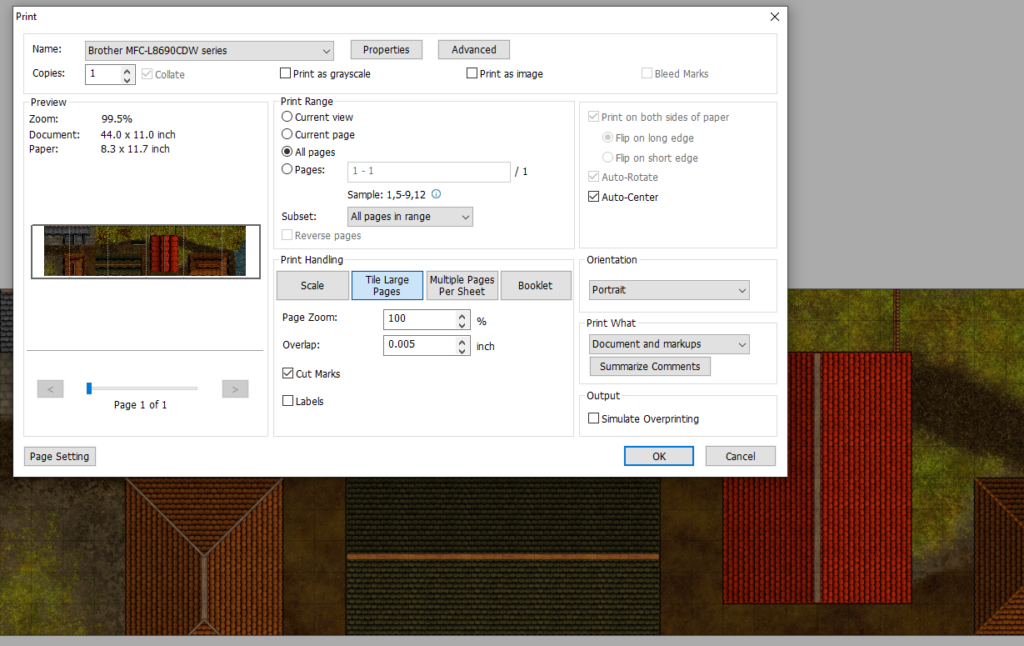
Open your PDF in an appropriate reader application with good print management. I’m using Foxit, which is… okay? Print it, selecting “tile large pages” to tell it to print across multiple sheets. Assuming you’ve produced a map an appropriate size for your printer’s margins, your preview should be perfect. If not, you can get away with reducing the zoom level by up to a percent or two without causing trouble for your miniatures. If you’d like the page breaks to occur at specific places (for exposure/reveal reasons), go back to Gimp and pad one side of the image by increasing the canvas size.
Check the level of “overlap” specified: I like to keep mine low and use the print margins as the overlapping part of my maps when I tape them together, but you’ll want to see how your printer behaves and adapt accordingly.
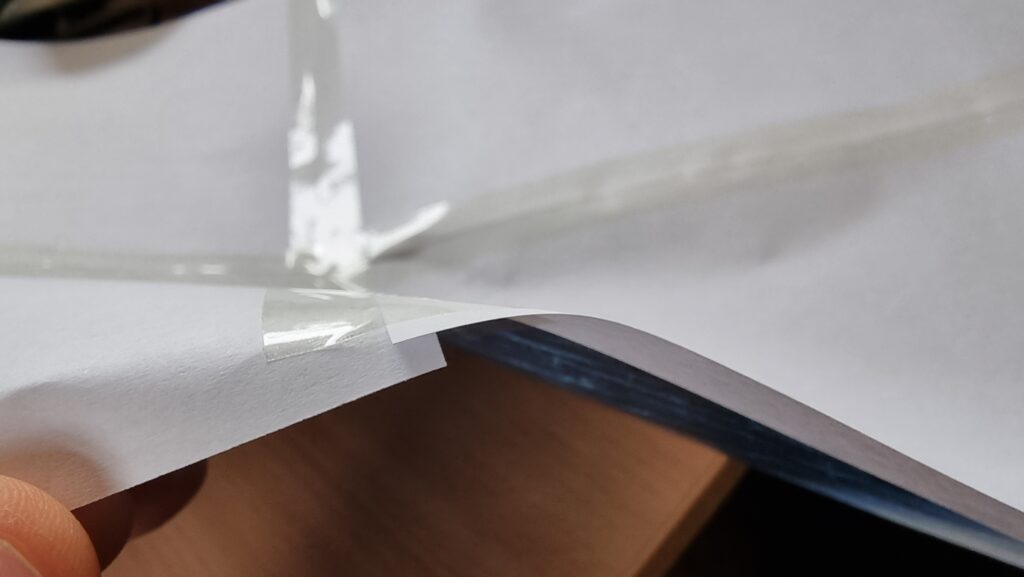
If you’re sticking together multiple pages to make a single large map, trim off the bottom and right margins of each page: if you printed with cut marks, this is easy enough even without a guillotine. Then tape them together on the underside, taking care to line-up the features on the map (it’s not just your players who’ll appreciate a good, visible grid: it’s useful when lining-up your printouts to stick, too!).
I keep my maps rolled-up in a box. If you do this too, just be ready with some paperweights to keep the edges from curling when you unfurl them across your gaming table. Or cut into separate rooms and mount to stiff card for that “jigsaw” effect! Whatever works best for you!
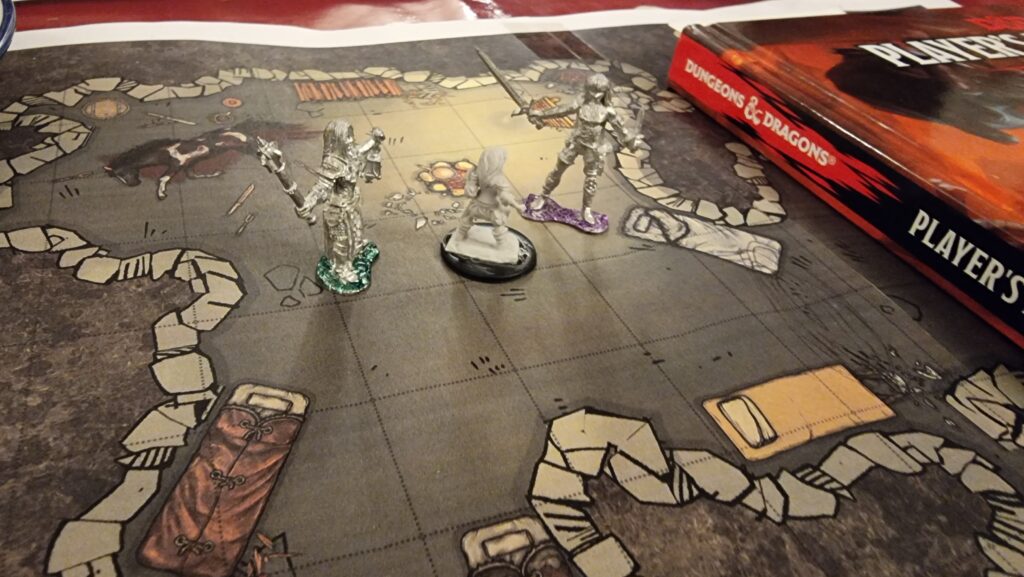
DNDle (Wordle, but with D&D monster stats)
Don’t have time to read? Just start playing:
There’s a Wordle clone for everybody
Am I too late to get onto the “making Wordle clones” bandwagon? Probably; there are quite a few now, including:
- Hundreds of different languages,
- Entirely different word sets (swear words, slang, bird banding codes, posix commands, common passwords…),
- Different games in the same style (absurdle plays adversarially like my cheating hangman game, crosswordle involves reverse-engineering a wordle colour grid into a crossword, heardle is like Wordle but sounding out words using the IPA…)
- Twists on the idea (try guessing prime numbers, equations, countries, chess openings, chords, or the composition of parties of fantasy adventurers…)
- Just plain silly ones (horsle, easy wordle, chortle…)
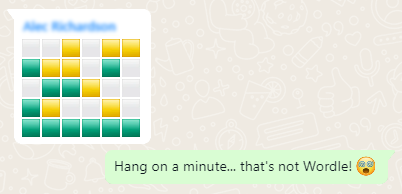
Now, a Wordle clone for D&D players!
But you know what hasn’t been seen before today? A Wordle clone where you have to guess a creature from the Dungeons & Dragons (5e) Monster Manual by putting numeric values into a character sheet (STR, DEX, CON, INT, WIS, CHA):
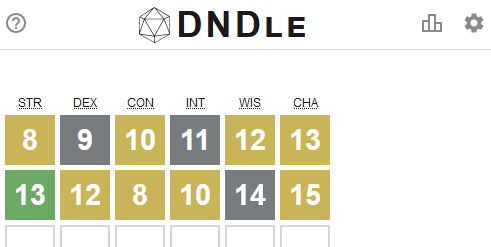
What are you waiting for: go give DNDle a try (I pronounce it “dindle”, but you can pronounce it however you like). A new monster appears at 10:00 UTC each day.
And because it’s me, of course it’s open source and works offline.
The boring techy bit
- Like Wordle, everything happens in your browser: this is a “backendless” web application.
- I’ve used ReefJS for state management, because I wanted something I could throw together quickly but I didn’t want to drown myself (or my players) in a heavyweight monster library. If you’ve not used Reef before, you should give it a go: it’s basically like React but a tenth of the footprint.
- A cache-first/background-updating service worker means that it can run completely offline: you can install it to your homescreen in the same way as Wordle, but once you’ve visited it once it can work indefinitely even if you never go online again.
- I don’t like to use a buildchain that’s any more-complicated than is absolutely necessary, so the only development dependency is rollup. It
resolves my
importstatements and bundles a single JS file for the browser.
Taking a Jackbox Zoom Party to the Next Level
A love a good Jackbox Game. There’s nothing quite like sitting around the living room playing Drawful, Champ’d Up, Job Job, Trivia Murder Party, or Patently Stupid. But nowadays getting together in the same place isn’t as easy as it used to be, and as often as not I find my Jackbox gaming with friends or coworkers takes place over Zoom, Around, Google Meet or Discord.
There’s lots of guides to doing this – even an official one! – but they all miss a few pro tips that I think can turn a good party into a great party. Get all of this set up before your guests are due to arrive to make yourself look like a super-prepared digital party master.
1. Use two computers!
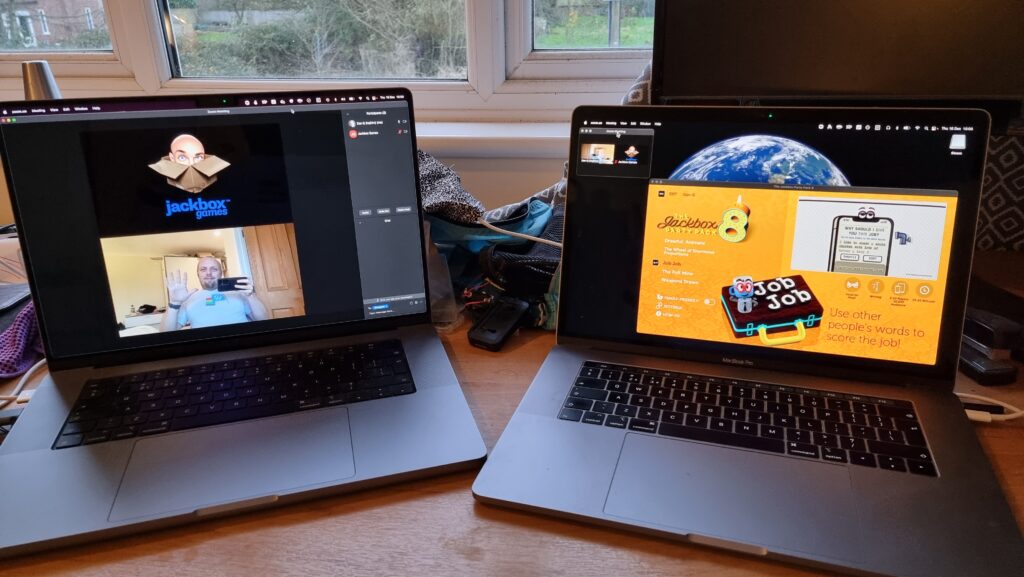
Using one computer for your video call and a second one to host the game (in addition to the device you’re using to play the games, which could be your phone) is really helpful for several reasons:
- You can keep your video chat full-screen without the game window getting in the way, letting you spend more time focussed on your friends.
- Your view of the main screen can be through the same screen-share that everybody else sees, helping you diagnose problems. It also means you experience similar video lag to everybody else, keeping things fair!
- You can shunt the second computer into a breakout room, giving your guests the freedom to hop in and out of a “social” space and a “gaming” space at will. (You can even set up further computers and have multiple different “game rooms” running at the same time!)
2. Check the volume
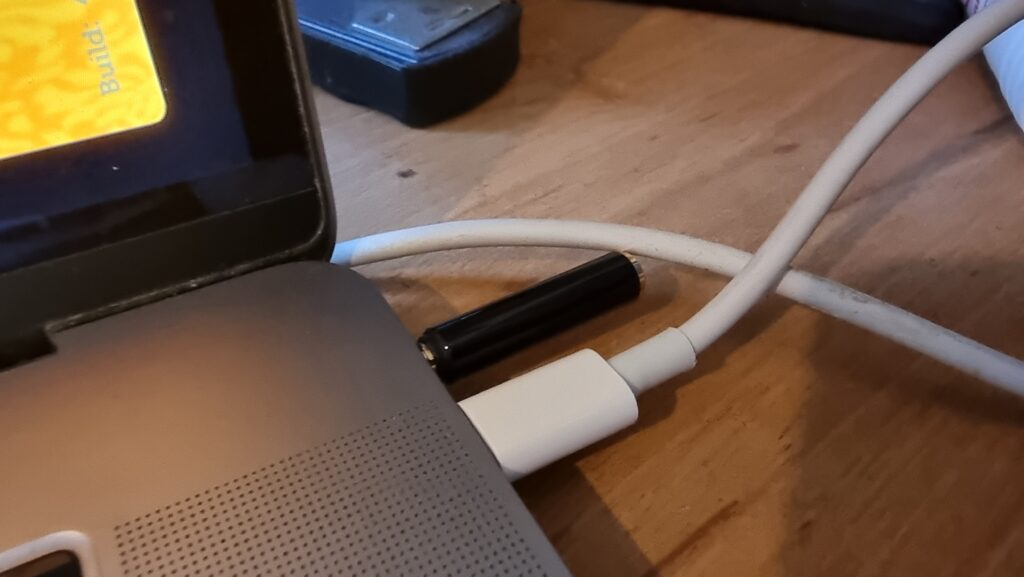
Connect some headphones to the computer that’s running the game (or set up a virtual audio output device if you’re feeling more technical). This means you can still have the game play sounds and transmit them over Zoom, but you’ll only hear the sounds that come through the screen share, not the sounds that come through the second computer too.
That’s helpful, because (a) it means you don’t get feedback or have to put up with an echo at your end, and (b) it means you’ll be hearing the game exactly the same as your guests hear it, allowing you to easily tweak the volume to a level that allows for conversation over it.
3. Optimise the game settings
Jackbox games were designed first and foremost for sofa gaming, and playing with friends over the Internet benefits from a couple of changes to the default settings.
Sometimes the settings can be found in the main menu of a party pack, and sometimes they’re buried in the game itself, so do your research and know your way around before your party starts.
Turn the volume down, especially the volume of the music, so you can have a conversation over the game. I’d also recommend disabling Full-screen Mode: this reduces the resolution of the game, meaning there’s less data for your video-conferencing software to stream, and makes it easier to set up screen sharing without switching back and forth between your applications (see below).
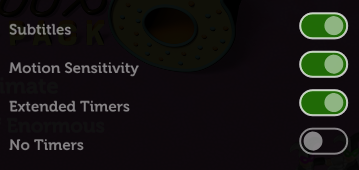
Turning on the Motion Sensitivity or Reduce Background Animations option if your game has it means there’ll be less movement in the background of the game. This can really help with the
video compression used in videoconferencing software, meaning players on lower-speed connections are less-likely to experience lag or “blockiness” in busy scenes.
It’s worth considering turning Subtitles on so that guests can work out what word they missed (which for the trivia games can be a big deal). Depending on your group, Extended Timers is worth considering too: the lag introduced by videoconferencing can frustrate players who submit answers at the last second only to discover that – after transmission delays – they missed the window! Extended Timers don’t solve that, but they do mean that such players are less-likely to end up waiting to the last second in the first place.
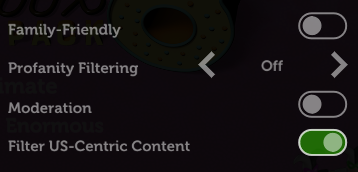
Finally: unless the vast majority or all of your guests are in the USA, you might like to flip the Filter US-Centric Content
switch so that you don’t get a bunch of people scratching their heads over a cultural reference that they just don’t get.
By the way, you can use your cursor keys and enter to operate Jackbox games menus, which is usually easier than fiddling with a mouse.
4. Optimise Zoom’s settings
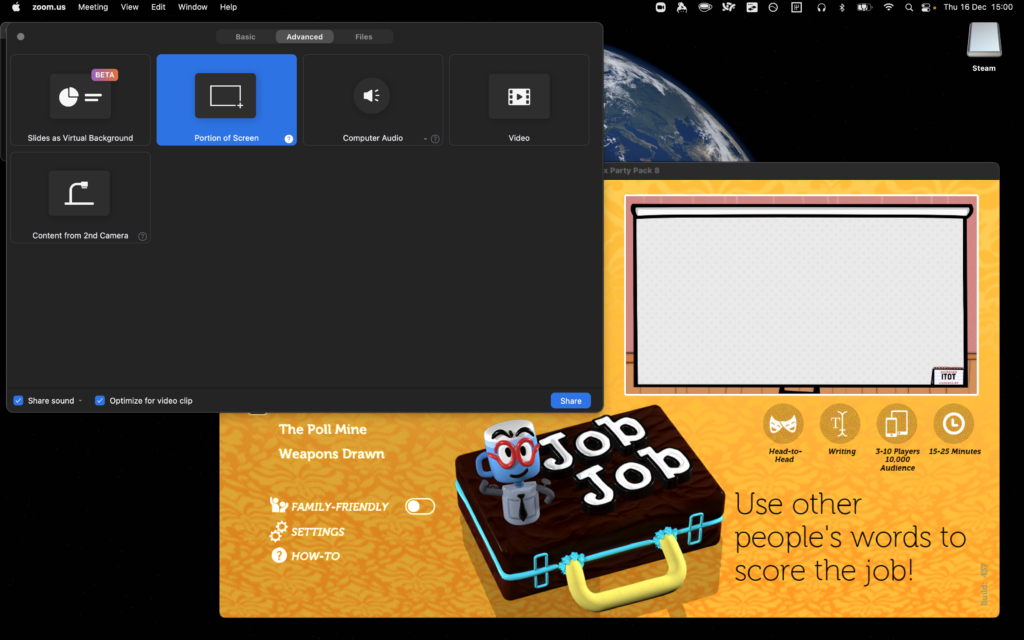
Whatever videoconferencing platform you’re using, the settings for screen sharing are usually broadly similar. I suggest:
- Make sure you’ve ticked “Share sound” or a similar setting that broadcasts the game’s audio: in some games, this is crucial; in others, it’s nice-to-have. Use your other computer to test how it sounds and tweak the volume accordingly.
- Check “Optimize for video clip”; this hints to your videoconferencing software that all parts of the content could be moving at once so it can use the same kind of codec it would for sending video of your face. The alternative assumes that most of the screen will stay static (because it’s the desktop, the background of your slides, or whatever), which works better with a different kind of codec.
- Use “Portion of Screen” sharing rather than selecting the application. This ensures that you can select just the parts of the application that have content in, and not “black bars”, window chrome and the like, which looks more-professional as well as sending less data over the connection.
- If your platform allows it, consider making the mouse cursor invisible in the shared content: this means that you won’t end up with an annoying cursor sitting in the middle of the screen and getting in the way of text, and makes menu operation look slicker if you end up using the mouse instead of the keyboard for some reason.
Don’t forget to shut down any software that might “pop up” notifications: chat applications, your email client, etc.: the last thing you want is somebody to send you a naughty picture over WhatsApp and the desktop client to show it to everybody else in your party!
Tick Tock
Looking for something with an “escape room” vibe for our date night this week, Ruth and I tried Tick Tock: A Tale for Two, a multiplayer simultaneous cooperative play game for two people, produced by Other Tales Interactive. It was amazing and I’d highly recommend it.
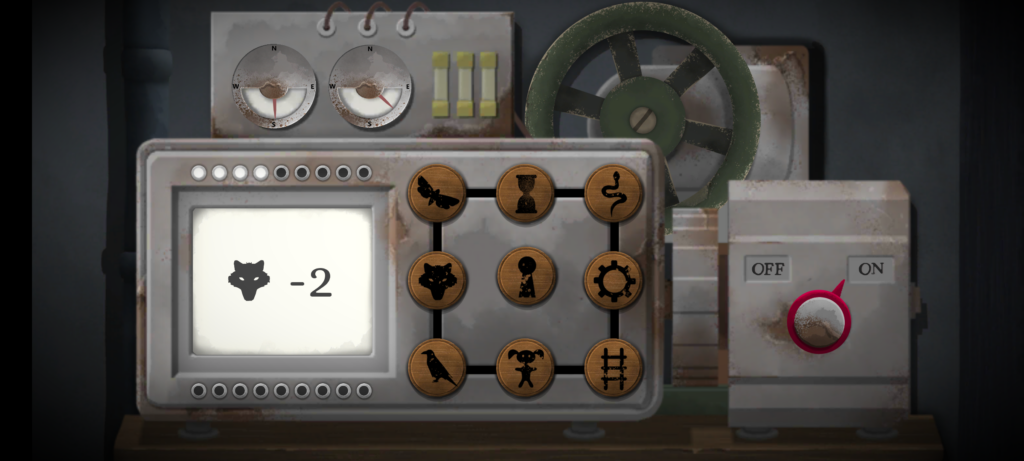
The game’s available on a variety of platforms: Windows, Mac, Android, iOS, and Nintendo Switch. We opted for the Android version because, thanks to Google Play Family Library, this meant we only had to buy one copy (you need it installed on both devices you’re playing it on, although both devices don’t have to be of the same type: you could use an iPhone and a Nintendo Switch for example).
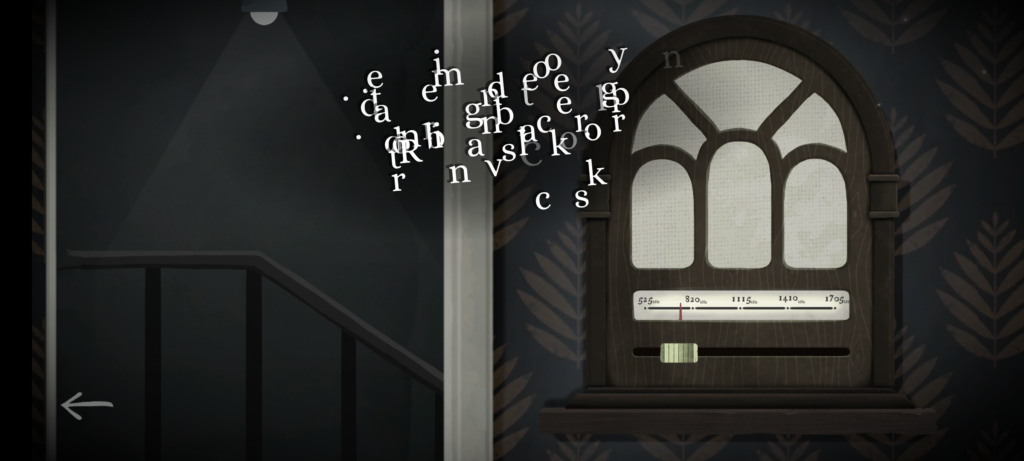
The really clever bit from a technical perspective is that the two devices don’t communicate with one another. You could put your devices in flight mode and this game would still work just fine! Instead, the gameplay functions by, at any given time, giving you either (a) a puzzle for which the other person’s device will provide the solution, or (b) a puzzle that you both share, but for which each device only gives you half of the clues you need. By working as a team and communicating effectively (think Keep Talking and Nobody Explodes but without the time pressure), you and your partner will solve the puzzles and progress the plot.
(We’re purists for this kind of puzzle game so we didn’t look at one another’s screens, but I can see how it’d be tempting to “cheat” in this way, especially given that even the guys in the trailer do so!)
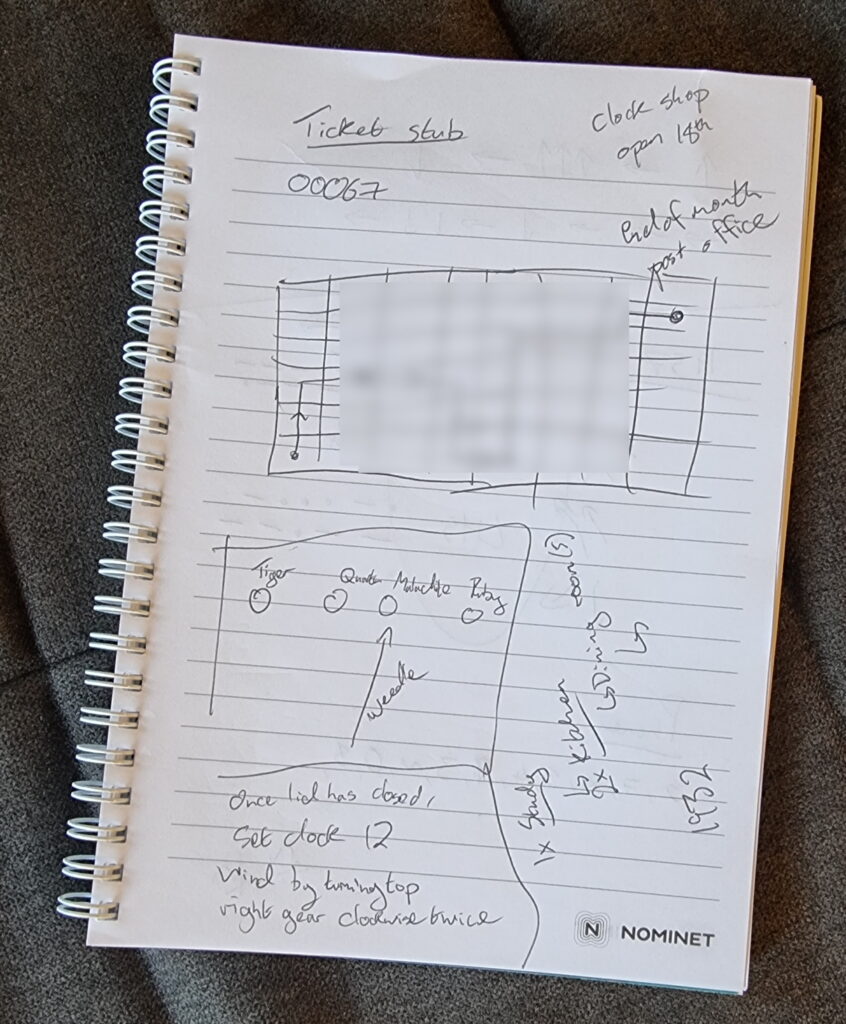
The puzzles start easy enough, to the extent that we were worried that the entire experience might not be challenging for us. But the second of the three acts proved us wrong and we had to step up our communication and coordination, and the final act had one puzzle that had us scratching our heads for some time! Quite an enjoyable difficulty curve, but still balanced to make sure that we got to a solution, together, in the end. That’s a hard thing to achieve in a game, and deserves praise.
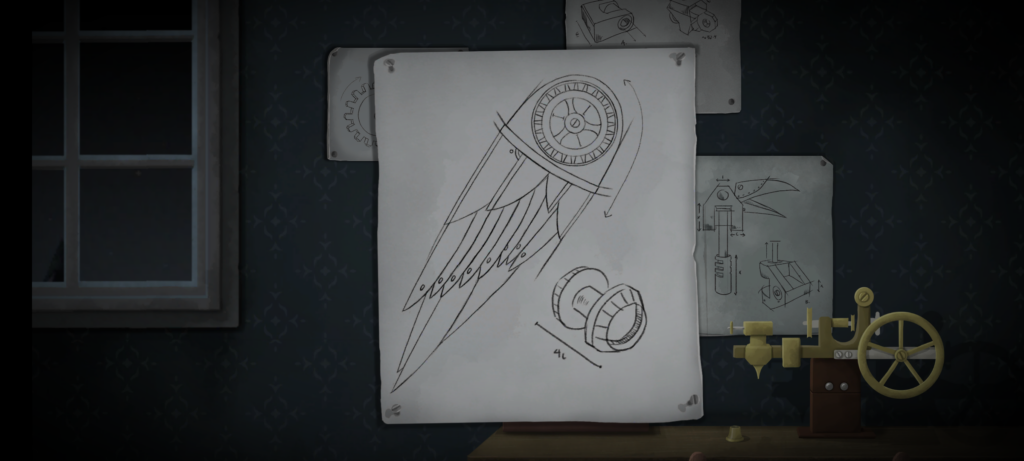
The plot is a little abstract at times and it’s hard to work out exactly what role we, the protagonists, play until right at the end. That’s a bit of a shame, but not in itself a reason to reject this wonderful gem of a game. We spent 72 minutes playing it, although that includes a break in the middle to eat a delivery curry.
If you’re looking for something a bit different for a quiet night in with somebody special, it’s well worth a look.
Mow-Rio Kart
This article is a repost promoting content originally published elsewhere. See more things Dan's reposted.
I have this exact same ride-on mower, but mine doesn’t do this. I feel cheated.
Twinebook – Printable Interactive Fiction
Twine 2 is a popular tool for making hypertext interactive fiction, but there’s something about physical printed “choose your own adventure”-style gamebooks that isn’t quite replicated when you’re playing on the Web. Maybe it’s the experience of keeping your finger in a page break to facilitate a “save point” for when you inevitably have to backtrack and try again?
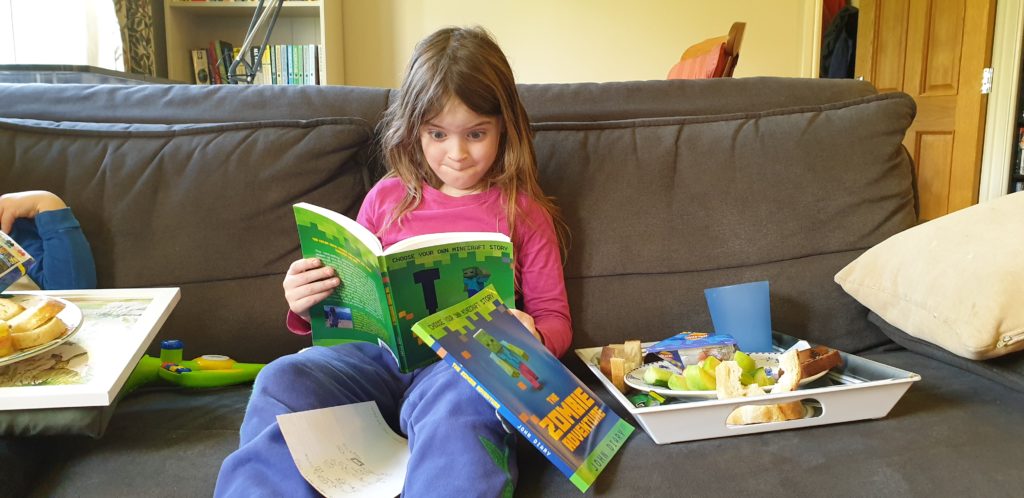
As a medium for interactive adventures, paper isn’t dead! Our 7-year-old is currently tackling the second part of a series of books by John Diary, the latest part of which was only published in December! But I worry that authors of printed interactive fiction might have a harder time than those producing hypertext versions. Keeping track of all of your cross-references and routes is harder than writing linear fiction, and in the hypertext
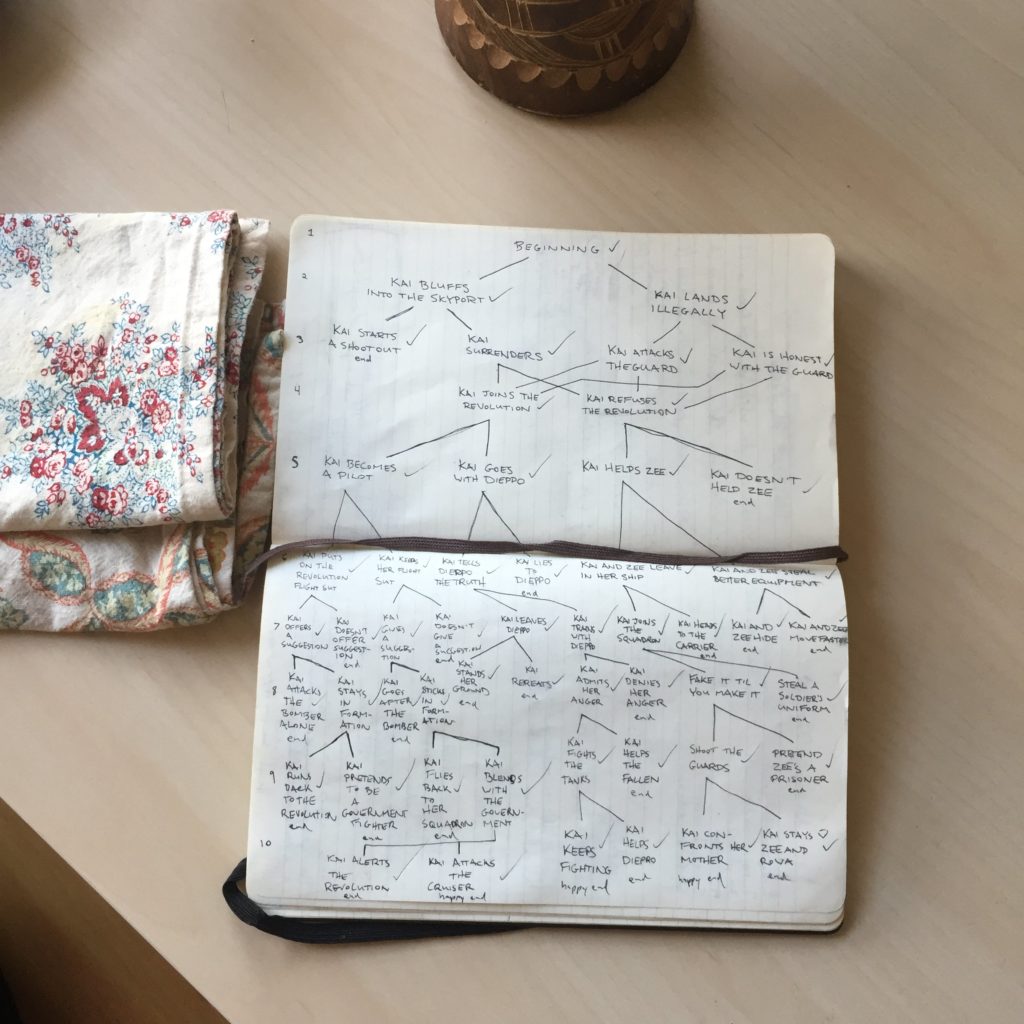
Twinebook
So I’ve thrown together Twinebook, an experimental/prototype tool which aims to bring the feature-rich toolset of Twine to authors of paper-based interactive fiction. Simply: you upload your compiled Twine HTML to Twinebook and it gives you a printable PDF file, replacing the hyperlinks with references in the style of “turn to 27” to instruct the player where to go next. By default, the passages are all scrambled to keep it interesting, but with the starting passage in position 1… but it’s possible to override this for specific passages to facilitate puzzles that require flipping to specific numbered passages.
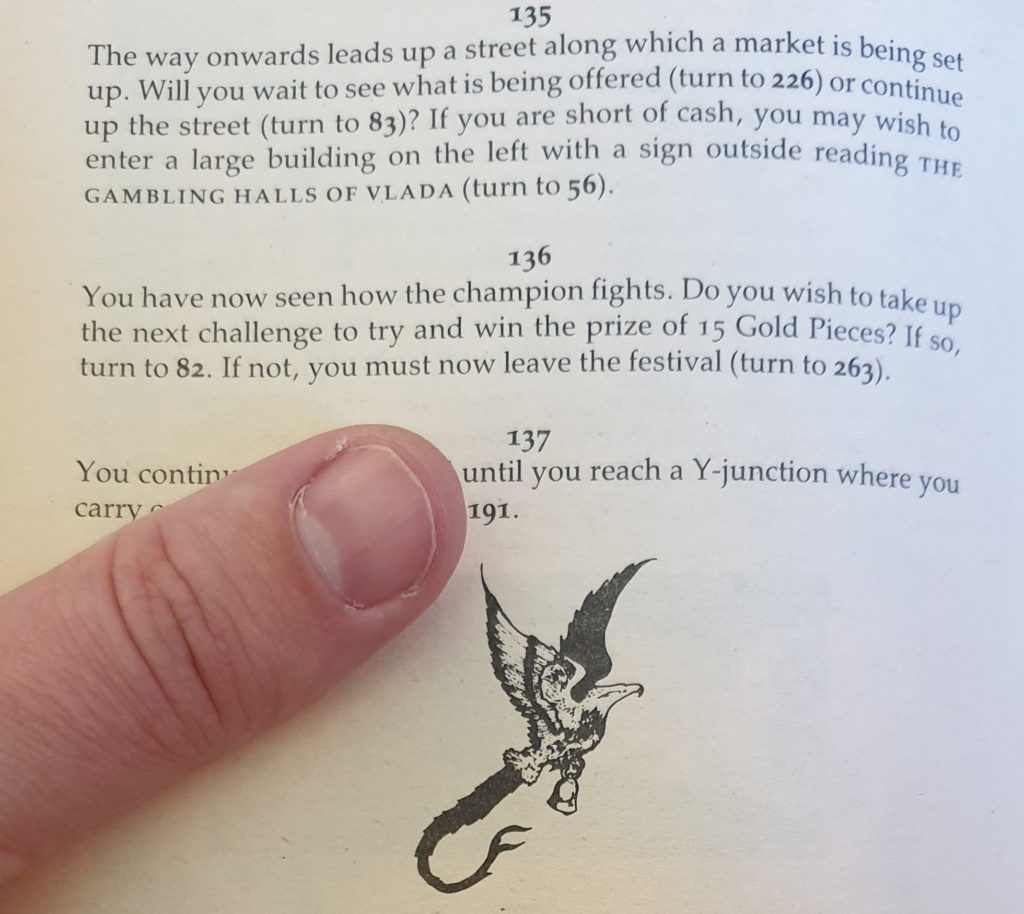
Obviously, it doesn’t work with any kind of “advanced” Twine game – anything that makes use of variables, Javascript, etc., for example! – unless you can think of a way to translate these into the written word… which is certainly possible – see Fighting Fantasy‘s skill, stamina, luck and dice-rolling mechanics, for example! – but whether it’s desirable is up to individual authors.
If this tool is valuable to anybody, that’s great! Naturally I’ve open-sourced the whole thing so others can expand on it if they like. If you find it useful, let me know.
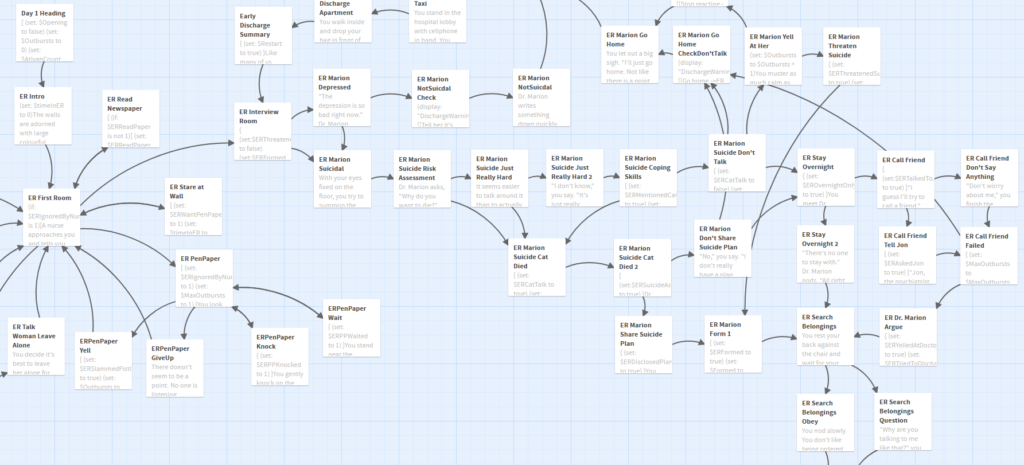
If you’re interested in the possibility of using Twine to streamline the production of printable interactive fiction, give my Twinebook prototype a try and let me know what you think.
The Ballad of John Crawford
Following the success of our last game of Dialect the previous month and once again in a one-week hiatus of our usual Friday Dungeons & Dragons game, I hosted a second remote game of this strange “soft” RPG with linguistics and improv drama elements.
Thieves’ Cant
Our backdrop to this story was Portsmouth in 1834, where we were part of a group – the Gunwharf Ants – who worked as stevedores and made our living (on top of the abysmal wages for manual handling) through the criminal pursuit of “skimming a little off the top” of the bulk-break cargo we moved between ships and onto and off the canal. These stolen goods would be hidden in the basement of nearby pub The Duke of Wellington until they could be safely fenced, and this often-lucrative enterprise made us the envy of many of the docklands’ other criminal gangs.
I played Katie – “Kegs” to her friends – the proprietor of the Duke (since her husband’s death) and matriarch of the group. I was joined by Nuek (Alec), a Scandinavian friend with a wealth of criminal experience, John “Tuck” Crawford (Matt), adoptee of the gang and our aspiring quartermaster, and “Yellow” Mathias Hammond (Simon), a navy deserter who consistently delivers better than he expects to.
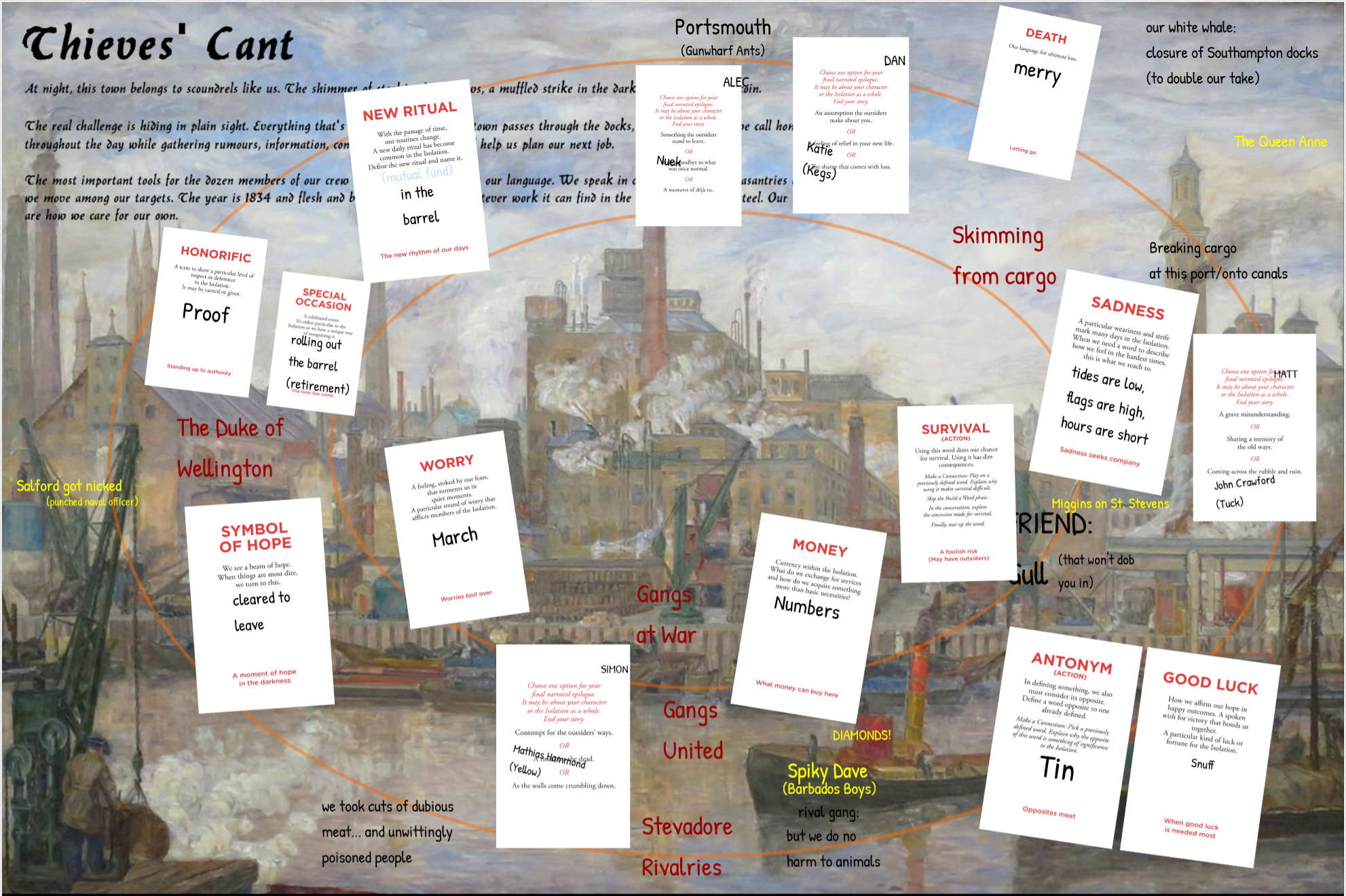
While each of us had our stories and some beautiful and hilarious moments, I felt that we all quickly converged on the idea that the principal storyline in our isolation was that of young Tuck. The first act was dominated by his efforts to proof himself to the gang, and – with a little snuff – shake off his reputation as the “kid” of the group and gain acceptance amongst his peers. His chance to prove himself with a caper aboard the Queen Anne went proper merry though after she turned up tin-ful and he found himself kept in a second-place position for years longer. Tuck – and Yellow – got proofed eventually, but the extra time spent living hand-to-mouth might have been what first planted the seed of charity in the young man’s head, and kept most of his numbers out of his pocket and into those of the families he supported in the St. Stevens area.
The second act turned political, as Spiky Dave, leader of the competing gang The Barbados Boys, based over Gosport way, offered a truce between the two rivals in exchange for sharing the manpower – and profits – of a big job against a ship from South Africa… with a case of diamonds aboard. Disagreements over the deal undermined Kegs’ authority over the Ants, but despite their March it went ahead anyway and the job was a success. Except… Spiky Dave kept more than his share of the loot, and agreed to share what was promised only in exchange for the surrender of the Ants and their territory to his gang’s rulership.
We returned to interpersonal drama in the third act as Katie – tired of the gang wars and feeling her age – took perhaps more than her fair share of the barrel (the gang’s shared social care fund) and bought herself clearance to leave aboard a ship to a beachside retirement in Jamaica. She gave up her stake in the future of the gang and shrugged off their challenges in exchange for a quiet life, leaving Nuek as the senior remaining leader of the group… but Tuck the owner of the Duke of Wellington. The gang split into those that integrated with their rivals and those that went their separate ways… and their curious pidgin dissolved with them. Well, except for a few terms which hung on in dockside gang chatter, screeched amongst the gulls of Portsmouth without knowing their significance, for years to come.
Playing Out
Despite being fundamentally the same game and a similar setting to when we played The Outpost the previous month, this game felt very different. Dialect is versatile enough that it can be used to write… adventures, coming-of-age tales, rags-to-riches stories, a comedies, horror, romance… and unless the tone is explicitly set out at the start then it’ll (hopefully) settle somewhere mutually-acceptable to all of the players. But with a new game, new setting, and new players, it’s inevitable that a different kind of story will be told.
But more than that, the backdrop itself impacted on the tale we wove. On Mars, we were physically isolated from the rest of humankind and living in an environment in which the necessities of a new lifestyle and society necessitates new language. But the isolation of criminal gangs in Portsmouth docklands in the late Georgian era is a very different kind: it’s a partial isolation, imposed (where it is) by its members and to a lesser extent by the society around them. Which meant that while their language was still a defining aspect of their isolation, it also felt more-artificial; deliberately so, because those who developed it did so specifically in order to communicate surreptitiously… and, we discovered, to encode their group’s identity into their pidgin.
While our first game of Dialect felt like the language lead the story, this second game felt more like the language and the story co-evolved but were mostly unrelated. That’s not necessarily a problem, and I think we all had fun, but it wasn’t what we expected. I’m glad this wasn’t our first experience of Dialect, because if it were I think it might have tainted our understanding of what the game can be.
As with The Outpost, we found that some of the concepts we came up with didn’t see much use: on Mars, the concept of fibs was rooted in a history of of how our medical records were linked to one another (for e.g. transplant compatibility), but aside from our shared understanding of the background of the word this storyline didn’t really come up. Similarly, in Thieves Cant’ we developed a background about the (vegan!) roots of our gang’s ethics, but it barely got used as more than conversational flavour. In both cases I’ve wondered, after the fact, whether a “flashback” scene framed from one of our prompts might have helped solidify the concept. But I’m also not sure whether or not such a thing would be necessary. We seemed to collectively latch onto a story hook – this time around, centred around Matt’s character John Crawford’s life and our influences on it – and it played out fine.
And hey; nobody died before the epilogue, this time!
I’m looking forward to another game next time we’re on a D&D break, or perhaps some other time.
We Are The Martians
This week our usual Dungeons & Dragons group took a week off while our DM recovered from a long and tiring week. As a “filler”, I offered to facilitate a game of Dialect: A Game About Language and How It Dies, from Thorny Games, who I discovered through a Metafilter post about their latest free print-and-play game, Sign: A Game about Being Understood. Yes, all of their games about about language and communication; what of it?
Dialect
Dialect could be described as a rules-light, GM-less (it has a “facilitator” role, but they have no more authority than any player on anything), narrative-driven/storytelling roleplaying game based on the concept of isolated groups developing their own unique dialect and using the words they develop as a vehicle to tell their stories.
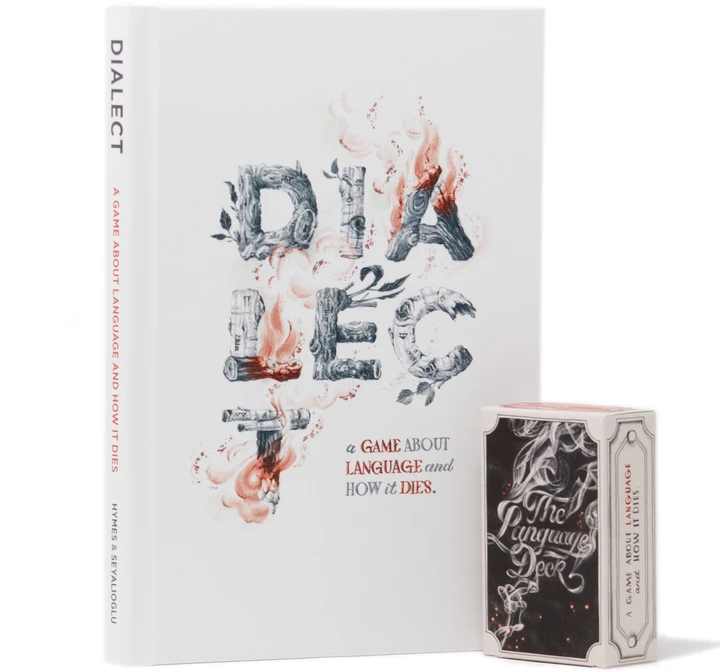
This might not be the kind of RPG that everybody likes to play – if you like your rules more-structured, for example, or you’re not a fan of “one-shot”/”beer and pretzels” gaming – but I was able to grab a subset of our usual roleplayers – Alec, Matt R, Penny, and I – and have a game (with thanks to Google Meet for videoconferencing and Roll20 for the virtual tabletop: I’d have used Foundry but its card support is still pretty terrible!).
The Outpost
A game of Dialect begins with a backdrop – what other games might call a scenario or adventure – to set the scene. We opted for The Outpost, which put the four of us among the first two thousand humans to colonise Mars, landing in 2045. With help from some prompts provided by the backdrop we expanded our situation in order to declare the “aspects” that would underpin our story, and then expand on these to gain a shared understanding of our world and society:
- Refugees from plague: Our expedition left Earth to escape from a series of devastating plagues that were ravaging the planet, to try to get a fresh start on another world.
- Hostile environment: Life on Mars is dominated by the ongoing struggle for sufficient food and water; we get by, but only thanks to ongoing effort and discipline and we lack some industries that we haven’t been able to bootstrap in the five years we’ve been here (we had originally thought that others would follow).
- Functionalist, duty-driven society: The combination of these two factors led us to form a society based on supporting its own needs; somewhat short of a caste system, our culture is one of utilitarianism and unity.
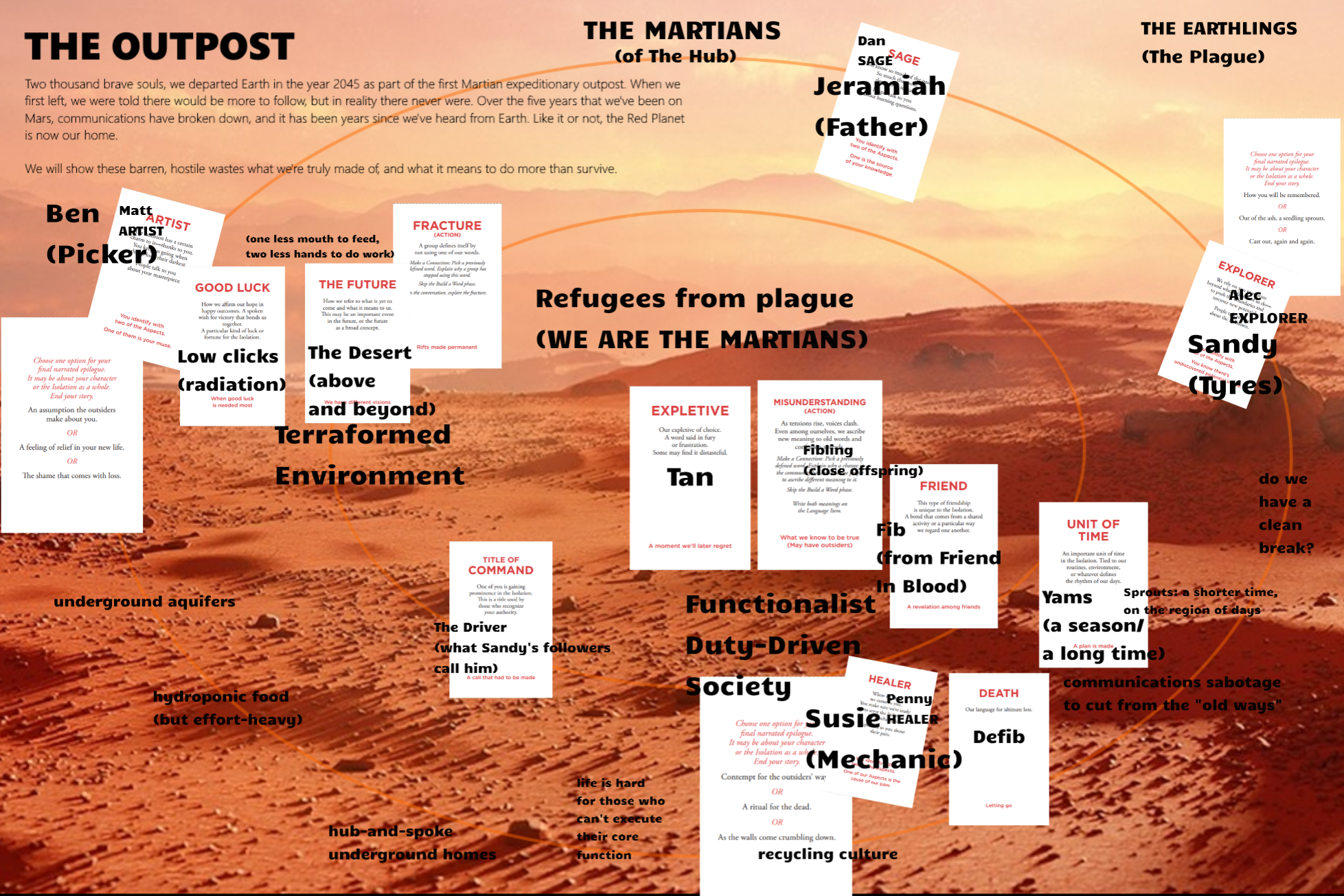
It soon became apparent that communication with Earth had been severed, at least initially, from our end: radicals, seeing the successes of our new social and economic systems, wanted to cement our differences by severing ties with the old world. And so our society lives in a hub-and-spoke cave system beneath the Martian desert, self-sustaining except for the need to send rovers patrolling the surface to scout for and collect valuable surface minerals.
In this world, and prompted by our cards, we each developed a character. I was Jeramiah, the self-appointed “father” of the expedition and of this unusual new social order, who remembers the last disasters and wars of old Earth and has revolutionary plans for a better world here on Mars, based on controlled growth and a planned economy. Alec played Sandy – “Tyres” to their friends – a rover-driving explorer with one eye always on the horizon and fresh stories for the colony brought back from behind every new crater and mountain. Penny played Susie, acting not only as the senior medic to the expedition but something more: sort-of the “mechanic” of our people-driven underground machine, working to keep alive the genetic records we’d brought from Earth and keep them up-to-date as our society eventually grew, in order to prevent the same kinds of catastrophe happening here. “Picker” Ben was our artist, for even a functionalist society needs somebody to record its stories, celebrate its accomplishments, and inspire its people. It’s possible that the existence of his position was Jeramiah’s doing: the two share a respect for the stark, barren, undeveloped beauty of the Martian surface.
We developed our language using prompt cards, improvised dialogue, and the needs of our society. But the decades that followed brought great change. More probes began to land from Earth, more sophisticated than the ones that had delivered us here. They brought automated terraforming equipment, great machines that began to transform Mars from a barren wasteland into a place for humans to thrive. These changes fractured our society: there were those that saw opportunity in this change – a chance to go above ground and live in the sun, to expand across the planet, to make easier the struggle of our day-to-day lives. But others saw it as a threat: to our way of life, which had been shaped by our challenging environment; to our great social experiment, which could be ruined by the promise of an excessive lifestyle; to our independence, as these probes were clearly the harbingers of the long-promised second wave from Earth.
Even as new colonies were founded, the Martians of the Hub (the true Martians, who’d been here for yams time, lived and defibed here, not these tanning desert-dwelers that followed) resisted the change, but it was always going to be a losing battle. Jeramiah took his last breath in an environment suit atop a dusty Martian mountain a day’s drive from the Hub, watching the last of the nearby deserts that was still untouched by the new green plants that had begun to spread across the surface. He was with his friend Sandy, for despite all of the culture’s efforts to paint them as diametrically opposed leaders with different ideas of the future, they remained friends until the end. As the years went by and more and more colonists arrived, Sandy left for Phobos, always looking for a new horizon to explore. Sick of the growing number of people who couldn’t understand his language or his art, Ben pioneered an expedition to the far side of the planet where he lived alone, running a self-sustaining agri-home and exploring the hills until his dying day. We were never sure where Susie ended up, but it wasn’t Mars: she’d talked about joining humanity’s next big jump, to the moons of Jupiter, so perhaps she’s out there on one of the colonies of Titan or Europa. Maybe, low clicks, she’s even keeping our language alive out there.
Retrospective
The whole event was a lot of fun and I’m keen to repeat it, perhaps with a different group and a different backdrop. The usual folks know who they are, but if you’re not one of those and you want in next time we play, drop me a message of some kind.
Banners Begone!
This article is a repost promoting content originally published elsewhere. See more things Dan's reposted.
I quite enjoyed this progressive game: it’s a little bit different than most, the theming is fun, it lends itself to multiple strategies, and it’s not geared towards making you wait for longer and longer intervals (as is common in this genre): there’s always something you can be doing to get closer to your goal.
You’ll need a mouse with left and right buttons.
SPACEX – ISS Docking Simulator
This article is a repost promoting content originally published elsewhere. See more things Dan's reposted.
I managed to crack this on my second attempt, but then: I did play an ungodly amount of Kerbal Space Program a few years back. I guess this means I’m now qualified to be an astronaut, right? I’d better update my CV…
The Board Game Remix Kit
This article is a repost promoting content originally published elsewhere. See more things Dan's reposted.
New rules for old games! The Board Game Remix Kit is a collection of tips, tweaks, reimaginings and completely new games that you can play with the board and pieces from games you might already own: Monopoly, Cluedo, Scrabble and Trivial Pursuit.
The 26 rule tweaks and new games include:
- Full Houses: poker, but played with Monopoly properties
- Citygrid: a single-player city-building game
- Use Your Words: Scrabble with storytelling
- Them’s Fightin’ Words: a game of making anagrams, and arguing about which one would win in a fight
- Hunt the Lead Piping: hiding and searching for the Cluedo pieces in your actual house
- Guess Who Done It: A series of yes/no questions to identify the murderer (contributed by Meg Pickard)
- Zombie Mansion: use the lead piping to defend the Cluedo mansion
- Judy Garland on the Moon with a Bassoon: a drawing game that uses the answers to trivia questions as prompts
The Board Game Remix Kit was originally released in 2010 by the company Hide&Seek (which closed in 2014). We are releasing it here as a pdf (for phones/computers) and an epub (for ereaders) under a CC-BY-SA license.
If you enjoy the Kit and can afford it, please consider a donation to the World Health Organisation’s COVID-19 Response Fund.
Confined to your house? What a great opportunity to play board games with your fellow confinees.
Only got old family classics like Monopoly, Cluedo and Scrabble? Here’s a guide to mixing-them-up into new, fun, and highly-playable alternatives. Monopoly certainly needs it.
Mackerelmedia Fish
Normally this kind of thing would go into the ballooning dump of “things I’ve enjoyed on the Internet” that is my reposts archive. But sometimes something is so perfect that you have to try to help it see the widest audience it can, right? And today, that thing is: Mackerelmedia Fish.
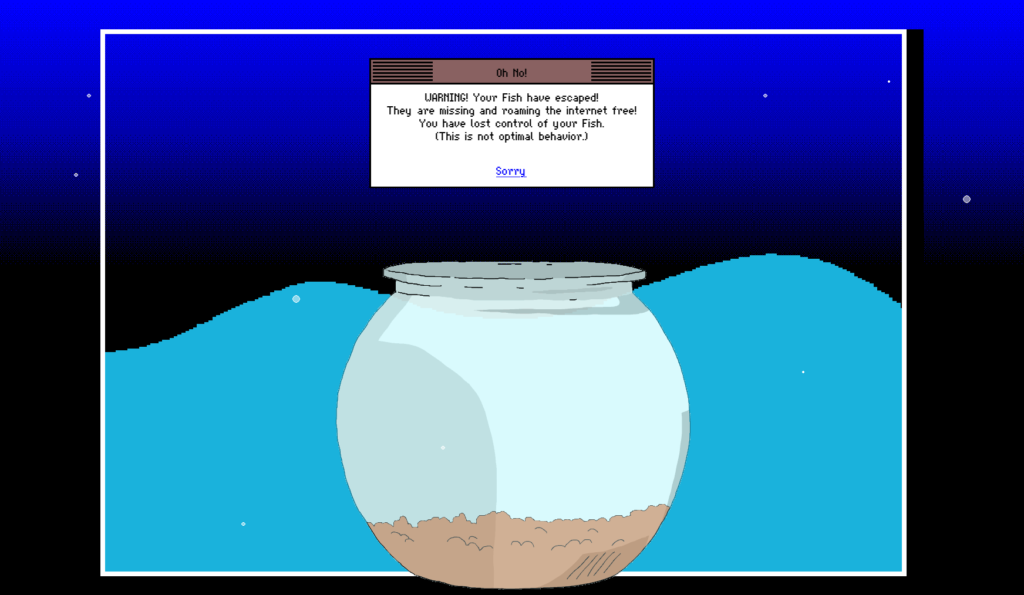
What is Mackerelmedia Fish? I’ve had a thorough and pretty complete experience of it, now, and I’m still not sure. It’s one or more (or none) of these, for sure, maybe:
- A point-and-click, text-based, or hypertext adventure?
- An homage to the fun and weird Web of yesteryear?
- A statement about the fragility of proprietary technologies on the Internet?
- An ARG set in a parallel universe in which the 1990s never ended?
- A series of surrealist art pieces connected by a loose narrative?
Rock Paper Shotgun’s article about it opens with “I don’t know where to begin with this—literally, figuratively, existentially?” That sounds about right.

What I can tell you with confident is what playing feels like. And what it feels like is the moment when you’ve gotten bored waiting for page 20 of Argon Zark to finish appear so you decide to reread your already-downloaded copy of the 1997 a.r.k bestof book, and for a moment you think to yourself: “Whoah; this must be what living in the future feels like!”
Because back then you didn’t yet have any concept that “living in the future” will involve scavenging for toilet paper while complaining that you can’t stream your favourite shows in 4K on your pocket-sized supercomputer until the weekend.
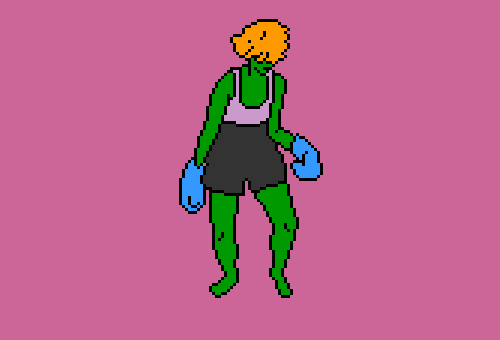
Mackerelmedia Fish is a mess of half-baked puns, retro graphics, outdated browsing paradigms and broken links. And that’s just part of what makes it great.
It’s also “a short story that’s about the loss of digital history”, its creator Nathalie Lawhead says. If that was her goal, I think she managed it admirably.
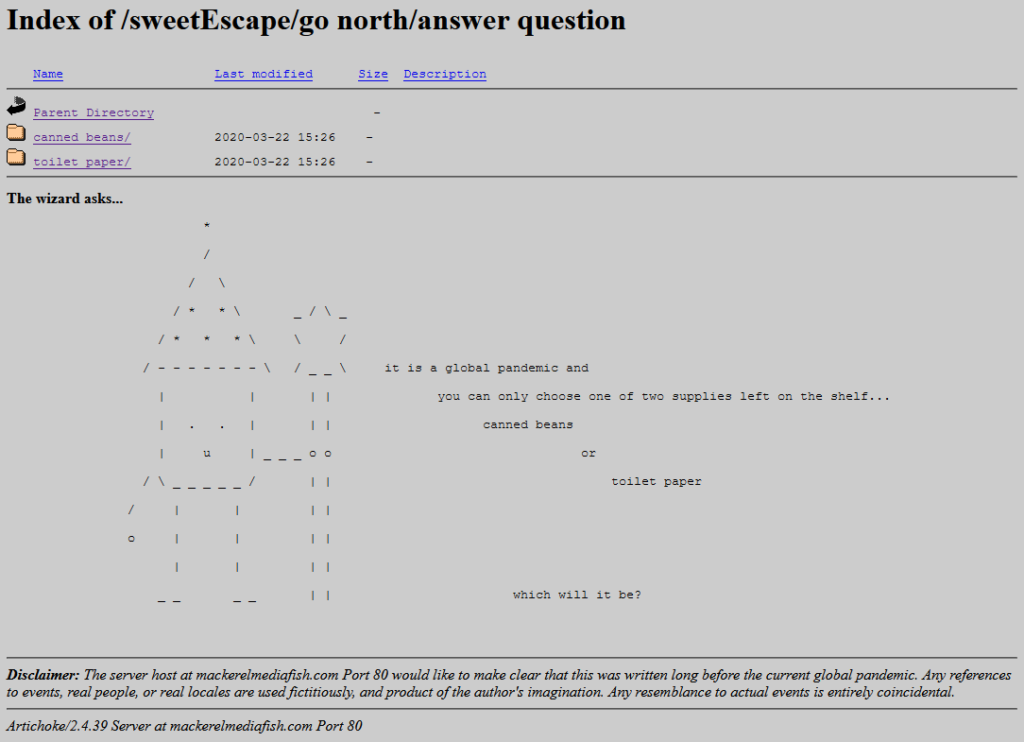
If I wasn’t already in love with the game already I would have been when I got to the bit where you navigate through the directory indexes of a series of deepening folders, choose-your-own-adventure style. Nathalie writes, of it:
One thing that I think is also unique about it is using an open directory as a choose your own adventure. The directories are branching. You explore them, and there’s text at the bottom (an htaccess header) that describes the folder you’re in, treating each directory as a landscape. You interact with the files that are in each of these folders, and uncover the story that way.
Back in the naughties I experimented with making choose-your-own-adventure games in exactly this way. I was experimenting with different media by which this kind of branching-choice game could be presented. I envisaged a project in which I’d showcase the same (or a set of related) stories through different approaches. One was “print” (or at least “printable”): came up with a Twee1-to-PDF converter to make “printable” gamebooks. A second was Web hypertext. A third – and this is the one which was most-similar to what Nathalie has now so expertly made real – was FTP! My thinking was that this would be an adventure game that could be played in a browser or even from the command line on any (then-contemporary: FTP clients aren’t so commonplace nowadays) computer. And then, like so many of my projects, the half-made version got put aside “for later” and forgotten about. My solution involved abusing the FTP protocol terribly, but it worked.
(I also looked into ways to make Gopher-powered hypertext fiction and toyed with the idea of using YouTube annotations to make an interactive story web [subsequently done amazingly by Wheezy Waiter, though the death of YouTube annotations in 2017 killed it]. And I’ve still got a prototype I’d like to get back to, someday, of a text-based adventure played entirely through your web browser’s debug console…! But time is not my friend… Maybe I ought to collaborate with somebody else to keep me on-course.)
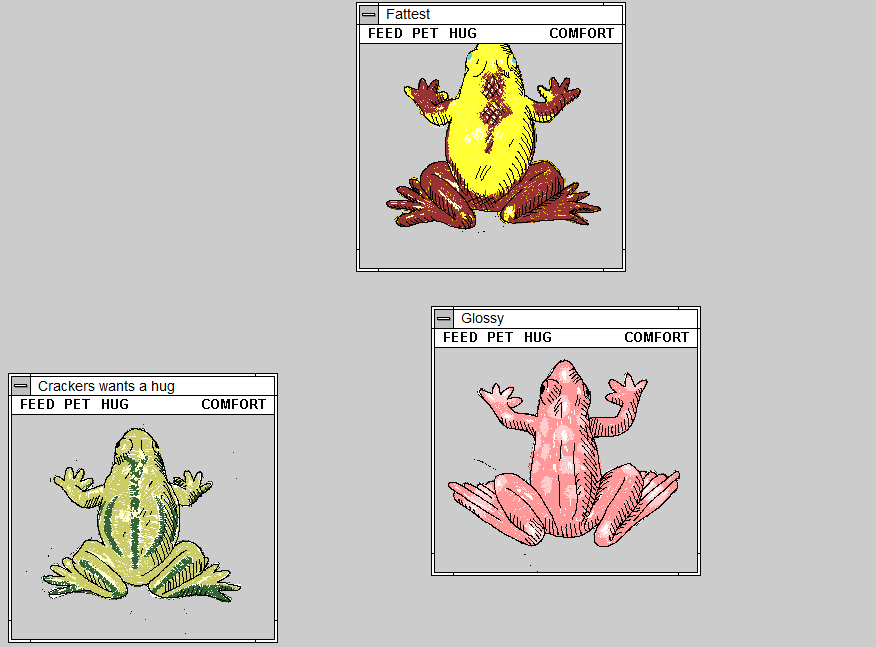
In any case: Mackerelmedia Fish is fun, weird, nostalgic, inspiring, and surreal, and you should give it a go. You’ll need to be on a Windows or OS X computer to get everything you can out of it, but there’s nothing to stop you starting out on your mobile, I imagine.
Sso long as you’re capable of at least 800 × 600 at 256 colours and have 4MB of RAM, if you know what I mean.
idTech 4 WebAssembly port – Doom 3 Demo
This article is a repost promoting content originally published elsewhere. See more things Dan's reposted.
Back in 2011, some folks cross-compiled Doom (the original, not the reboot, obviously) to JavaScript, leveraging the capabilities of the then-relatively-young
<canvas> element and APIs. I was really impressed to see that JavaScript had come so far and that
performance on desktop devices was so slick. Sure, this was an 18-year-old video game, but it was playable in a browser, which was a long way from the environment for which it
was originally developed.
Now Doom 3‘s playable in a browser, and my mind’s blown all over again. This follows almost the same curve – Doom 3’s 16 years old – but it still goes to show that there’s little limit to the power of client-side browser programming. They’ve done this magic with WebAssembly; while WebAssembly goes slightly against my ideas about the open-source nature of the Web, I still respect the power it commands to do heavyweight crunching tasks like this one.
How long until AAA developers start developing with the Web as an additional platform?
